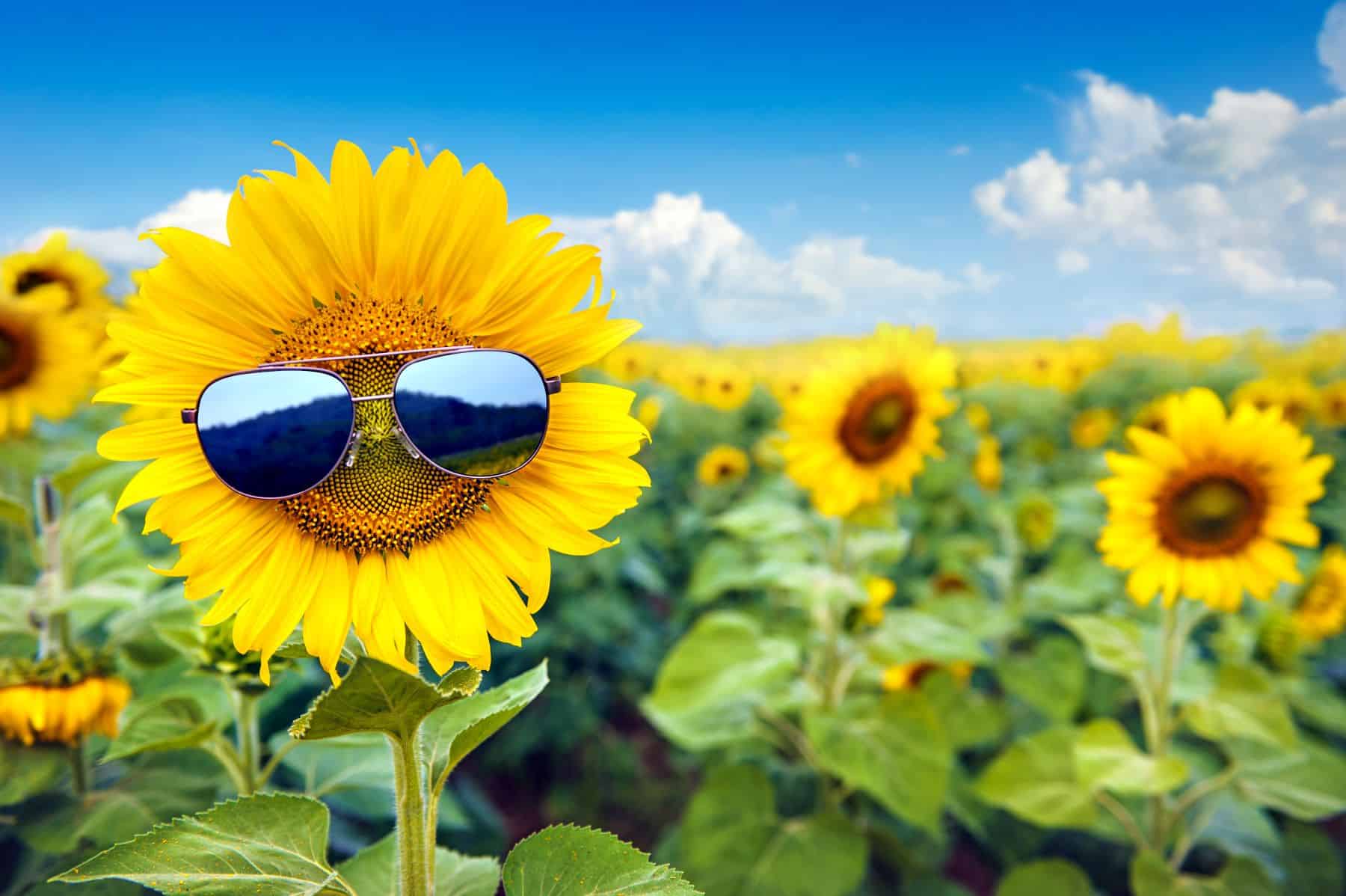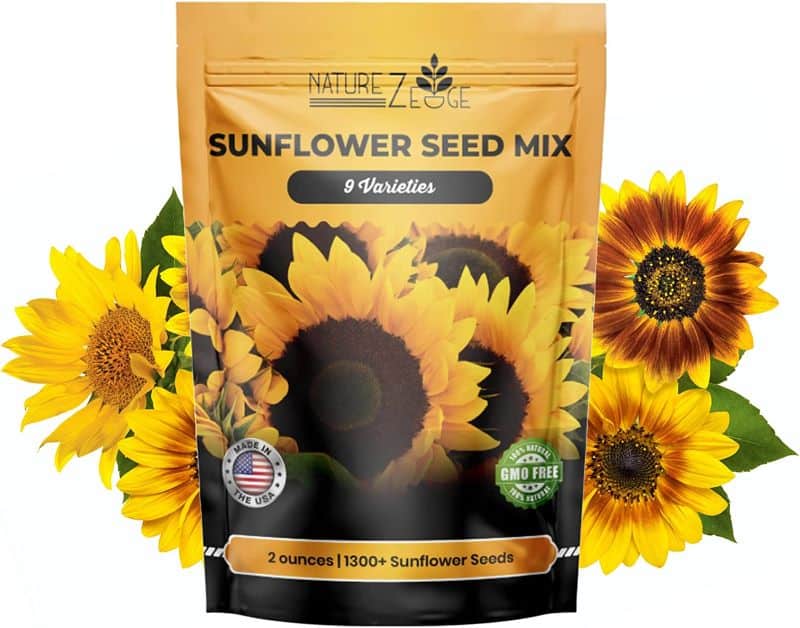
How to Grow Sunflowers: Classic Sunflowers and Popular Varieties.
Sunflowers are well-loved flowers that bloom all summer. Their cheerful faces brighten the garden. They come in different colors from traditional sunny yellow to dark shades of ruby and claret red. And other varieties can also come in orange, gold, and brownish tones.
Sunflowers are drought tolerant, resistant to pests, and attractive to pollinators and birds. Their large flowers make beautiful bouquets, and their seeds are a great source of food for birds and people.
So, if you have considered growing sunflowers in your garden, we have growing and care tips that will keep your sunflowers healthy and strong.
Types of Sunflowers
The classic sunflower goes by the botanical name of Helianthus annuus. The petals are bright yellow, and the large circular center (where the seeds form) is dark brown.
There are many varieties (or cultivars) of this classic sunflower. These include mammoth sunflower, Helianthus ‘Black Magic,’ Helianthus ‘Stella Gold,’ Lemon Queen, Orange Sun, red sunflower, and more. There are also sunflower-type plants that are completely different species, such as Mexican sunflower or red sunflower (Tithonia rotundifolia). But all of these sunflowers have similar growing requirements.
How to Grow Sunflowers
Most sunflower seeds are planted directly into the garden. Sunflower seeds are large, so they are easy to handle. They are also relatively easy to grow. Here are the basics for growing healthy sunflowers.
Sunlight Requirement
Sunflowers bloom in the summer climate, and they are heat and drought-tolerant. For the best flowering, plant your sunflower in full sun, so it gets six to eight hours of sunlight per day. So, make sure to seed your plant in a location that gets enough sunlight!
The warmer the temperature, the more they bloom. They are heliotrope or photo trope, so their head follows the direction of the sun. This helps them to remain straight and tall.
The Best Soil for Sunflowers
Sunflowers will grow best when they are planted in mixed soil that contains a good amount of organic matter. Some vermiculite can be added to larger pots, which will help lighten the weight of the potted plant.
In the garden, the soil should be well-drained and resistant to waterlogging. There should also be enough space to allow the roots to grow outward and deep. If the taproot can’t grow properly, the tall flower will have a poor foundation in resisting any strong wind.
Research produced by DissertationAssistance suggests that you need to keep a check to maintain a soil pH between 5.5 to 7.5. That’s because sunflowers grow best from slightly acidic to slightly alkaline. This will help the sunflower grow large and healthy with a prominent flower head.
When To Plant Sunflower Seeds
Sunflowers can be best grown from seed. They should be sowed directly into the garden, usually in spring. They can tolerate some cold, but if you plant them early, they will freeze and not grow to their full potential.
Plant seed in the garden 1 to 2 inches deep, spaced at least 6 inches apart. Keep them moist (but not soggy) until they germinate. This is a good way to bloom your sunflower earlier in the summer.
Sunflower seeds are easy to sow in the garden. Dozens of different varieties of sunflower seeds and sunflower seed mixes are available. For your convenience, here is a selection of sunflower seeds on Amazon. HG&H receives a small commission on sales.
How to Grow Sunflowers in Pots
When potting sunflowers, be sure to pick a variety that matches your space. If you want to pot a large flower, then you need a large pot that provides enough space for the roots to grow. A classic large sunflower needs a 12 to 16-inch pot for healthy growth.
You can start a single sunflower seed in a peat pot. This is a great project for kids, and it is a great way to get children excited about gardening. When the seedling has outgrown the peat pot, simply transplant it (peat pot and all) into a large container or outdoors in the garden.
How To Care For Sunflowers
Sunflowers are easy to care for. Just follow these tips.
Watering And Fertilizing
Although sunflowers are drought tolerant, they still require water to bloom. As the plant begins to grow, it needs to receive water around the root zone. Use a hose to water 3-4 inches away from the stem. Once the flower has been established, it can be watered once a week.
Sunflowers appreciate fertilizer. They can be grown in poor soil, but make sure to add a fertilizer rich in potassium and phosphorous. However, avoid adding fertilizer close to the plant’s base. This can provide too much nitrogen that can causes the stem to break or delay blooming.
Disease Prevention
Disease usually isn’t a problem with sunflowers. However, many birds and rodents are fond of sunflower seeds. So, if you want to protect your seed, cover it with white polyspun garden fleece. Moreover, the sunflower moth lays an egg on the flower head and leaves holes on it. Pesticides help to control the moth.
Keep your eye on the sunflower. It will help you to detect fungal diseases including powdery mildew and rust. Spray the plants with a general garden fungicide. It will protect them from the fungal spread.
How to Grow Sunflowers: Harvesting
For an indoor bouquet, cut the flower and place it in water. The seeds can be harvested when the back of the flower turns black and the seed head becomes dry.
Handle sunflowers gently. Rub the seed head with a smooth hand to collect the remaining seeds. Place the seeds in a paper or cloth bag. You can also leave the seed head intact on the plant for the birds to enjoy.
How to Grow Sunflowers: Conclusion
Sunflowers make a great addition to the garden that can be enjoyed in a variety of ways. Be sure to cut the flower properly. Their seed can be harvested and eaten as a healthy food which is rich in vitamins, calcium and iron.






Leave a Reply